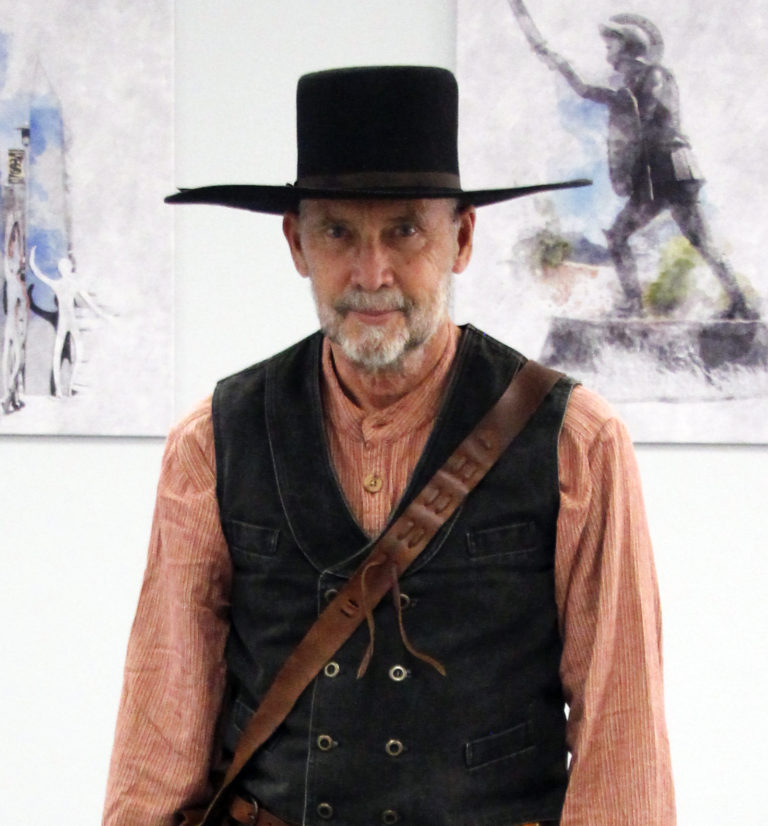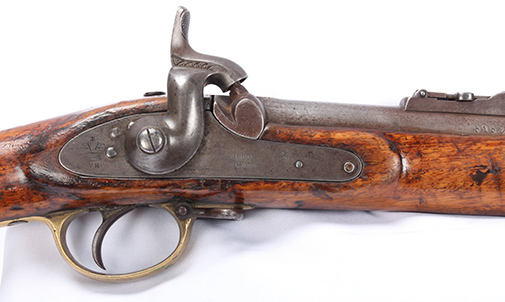Conserving Vintage Firearms
For details, call Donna Haddow at 719-846-5724.
Continuing Education only - not for college credit
Students will be introduced to the primary mainstream infantry rifles common during
the 100+ year "glory" of the British Empire, including:
• the "Brown Bess", a .70 caliber flint-lock, black powder ("BP"), smooth-bore, muzzle
loader (circa 1800);
• the Enfield Pattern 53 ("P53"), a .577 caliber percussion cap, BP, rifled muzzle
loader (circa 1856);
• the Snider-Enfield cartridge conversion of the P53 (circa 1862);
• the Martini-Henry, a .577/450, BP, necked cartridge, lever action (circa 1877);
and
• the Lee-Enfield, a .303 caliber, BP or smokeless powder, necked cartridge, bolt-action
(circa 1889).
Note 2: the only primary Empire infantry rifle I lack is the Baker Rifle -
if someone has one, PLEASE BRING IT!
Note 3: I consider the Brunswick (circa 1837) to be a transition model between the successful
Bess-type flint-locks and the excellent P53 percussion cap; although produced for
more than 50 years, I am not aware of its use in any significant combat arena. Again,
if you have one, please bring it to share with the class.
Caveat Emptor: Many thousands of "Kyber Pass" copies of the Bess, the Brunswick and P53 models were
fabricated, and many are still being marketed as originals. Fortunately, careful research
and examination can usually distinguish the clones from the originals.
For some of these models, I have carbine versions issued to mounted troops, and, sometimes,
artillerists. If time allows, I may present additional 19-Century military firearms,
e.g., the Springfield Trap-door (Model 1873), the Werndl, a strange Austrian design
(circa 1870), the revolutionary French 8mm Lebel (circa 1886), and the fantastic Mauser
Gewehr 98 (circa 1889).
We will fully disassemble each of these, and discuss techniques for detecting problems
in each of the mechanical components. To the extent possible, I will describe techniques
and sources for returning many of these components to functional condition. However,
great care MUST be taken if you decide to actually fire a truly vintage firearm. I
will discuss techniques for doing so, with the primary goal of protecting YOU from
possible injury, but also to minimize the risk that the gun will incur irreparable
damage or possible destruction.
Since the wooden stocks of many current examples of these fine weapons have been "refinished"
using modern coatings, e.g., varnish or (Heaven forbid!) polyurethane, I will demonstrate
my preferred techniques for removing these inappropriate finishes and restoring the
original RAW Linseed Oil finish.
Note 4: some of these chemicals are considered moderately hazardous (at least in California)
- students should advise me of any sensitivity to these types of solvents. If in doubt,
ASK!
Background: When it comes to the topic of preserving vintage firearms, opinions tend to be highly
polarized.
One school of thought insists that NOTHING be done to any firearm over about 50 years
old, and even the critical age is subject to spirited discussion. According to the
fundamental underlying theory of this group, these are "historical relics" and, thus,
it is our responsibility to preserve each of these firearms, as is, for posterity.
Thus, we should do nothing beyond the barest minimum to arrest any serious corrosion
of the metal components or decay of the wooden components ... and some extremists
consider even this "intervention" to be unacceptable.
The second school of thought tends to be more pragmatic, focusing more on the original
"form, fit and function" of each specimen than its current condition. According to
the fundamental underlying philosophy of this group, it is wholly unrealistic to assume
that any of these firearms is still in a condition comparable to when it was in its
prime. Rather, it is considered more reasonable to assume that, in its passage though
a long chain of possessors, at least one has, in some way, significantly altered the
original nature of the firearm, sometimes due to simple failure to maintain the gun
in proper working order, but more often in various attempts to adapt the gun to somewhat
different purposes than was originally intended. Thus, it is deemed entirely acceptable
to perform any of a number of "conservation" measures in an effort to restore the
firearm, to the extent reasonably possible, to its original "form, fit and function."
While I, personally, can fully respect the first approach, I have chosen to subscribe
to the second approach, especially in view of the fact that most, if not all, of the
really "vintage" firearms that are not already hidden away in private collections,
have been grossly modified in an effort to enhance their marketability to gullible
consumers. Not only are these "bastards" unworthy of treatment like authentic originals,
I submit that they deserve to be returned to as close to original condition as reasonably
possible. Note 1: I will NOT demonstrate ANY blueing or browning techniques as I deem
this action to be beyond the legitimate scope of "conservation".
Prerequisites:
Knowledge of basic rules of firearm safety. Basic skills employing standard hand tools
useful in disassembling and reassembling firearms. Although not required, I encourage
all students to bring at least one firearm older than 75 years, and, frankly, the
older the better! WWII specimens will be acceptable, but WWI or older would be more
appropriate.
About the Instructor:
Jeffrey Van Myers hails from the Brush Country of Deep South Texas. In 1954, at the
ripe old age of 8, he received, as a gift from a family friend, his first "vintage"
firearm - an original 1894 Stevens Favorite .22 rifle; the barrel is still shot out
and the unique "7 o'clock ejector" is still missing, but he still has it in his collection.
His love of these old classics dates from this very special event. Over the course
of the intervening years, he has collected, and conserved, many more of these "Old
Ladies". In part due to his 50+-year study of war, warfare and warriors, he has focused
primarily on military firearms, and, in particular, on the amazing series of infantry
rifles designed especially for use by the foot soldiers of the British Empire. However,
he has also collected and conserved specimens of the primary infantry rifles used
by all of the major participants in the Great War (WWI). One of his prize possessions
is a Japanese Arisaka Type 99, that he suspects was a "carry-back" from the battle
for Guadalcanal in 1942. Although still an active Patent Attorney, Jeffrey owns and
operates the Armeria del Sur, Driftwood, TX, and its international partner, Armeria
del Sur, in Costa Rica. He is a Viet Nam veteran, holds both an FFL and an FEL, and
has been attending summer classes at Trinidad since 2015.
Tools:
(Please keep in mind that the tools suggested for each class are the minimum tools
you should bring. Please feel free to bring any additional tools you feel you may
need)
Basic hand tools, preferably of smith quality, especially the screwdrivers and drift
punches (I use and recommend both Grace and Wheeler Engineering). If you bring something
special to share with the class and you happen to have any unique tools for your “old
friend”, please bring them as I may not have what we need to fully disassemble it.
Supplies:
- RAW (not “boiled”) linseed oil, approximately 1 qt. per project; this is rarely sold
in normal hardware/lumber stores, so I special order it on-line; “Sunnyside” brand
is what I use:
https://www.sunnysidecorp.com/product.php?p=cf&b=s&n=873G5 - Minwax Antique Furniture Refinisher, approximately 1 qt. per project – should be easy
to get at your local Home Depot:
http://www.minwax.com/wood-products/preparation/minwax-antique-furniture-refinisher - Mineral spirits – approximately 1 qt per project – may be furnished by the school.
- Ballistol – 4 oz bottle of liquid – I am a dealer and may be able to obtain samples for each student.
- Froglube – 4 oz paste – I am a dealer and may be able to obtain samples for each student:
http://shop.froglube.com/FrogLube-CLP-Paste-4-oz-Jar-FLP-P412.htm - Steel wool #0000 – 1 pkg, available at most hardware/lumber stores.
- Wet/dry sandpaper 220 and 400 grit; available in the Trinidad campus book store.
- Nitrile (or equivalent) gloves – 1 pkg (we will go through these pretty quickly, depending on the condition of the wood components).
- A US nickel – this, plus the Froglube, does an amazing job of removing surface rust!
Optional:
1. Given the difficulty of finding ammo for these really old guns, I am prepared to
teach the class how to cast bullets and then re-size to correct diameter, provided
that we have access to the bluing room during this portion of the class.
2. I may also have time to teach how to make a pretty good bullet lube from the following:
— Paraffin wax, unscented - 16 oz will make a nice batch; available in most grocery
stores, e.g., Walmart.
— Moly-fortified wheel bearing grease - 1 lb can; I like the Valvoline:
https://www.valvoline.com/our-products/grease-gear-oil/moly-fortified-multi-purpose-grease
— Lard - 1 lb box, available at most grocery stores.
— Muffin tin - makes convenient sized "pucks" when allowed to cool and harden.
— Cookie pan/sheet (needs a rim around all 4 sides) - used to immerse the lube groove(s)
of a batch of cast bullets, base down, in liquefied lube; when cooled and hardened,
the bullets can be extracted with the lube grooves full of the lube mix; something
like this (but does not need to be non-stick):
https://www.walmart.com/ip/Wilton-Bake-It-Better-10-x-15-Cookie-Sheet/25420423




